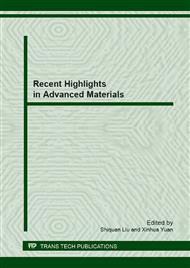[1]
G.L. Makar, J. Kruger, Corrosion studies of rapidly solidified magnesium alloy, J. Electrochem. Soc. 137 (1990) 414-421.
DOI: 10.1149/1.2086455
Google Scholar
[2]
E. Aghion, B. Bronfin, D. Elezer, The role of the magnesium industry in protecting the environment, J. Mater. Process Technol, 117 (2001) 381.
Google Scholar
[3]
H. F. Guo, M. Z. An, Growth of ceramic coatings on AZ91D magnesium alloys by micro-arc oxidation in aluminate-fluoride solutions and evaluation of corrosion resistance, Applied Surface Science, 246 (2005) 229-238.
DOI: 10.1016/j.apsusc.2004.11.031
Google Scholar
[4]
H. Y. Hsiao, W. T. Tsai, Characterization of anodic films formed on AZ91D magnesium alloy, Surface and Coatings Technology, 190 (2005) 299-308.
DOI: 10.1016/j.surfcoat.2004.03.010
Google Scholar
[5]
G. J. Li, L. Li, C.Q. Xu, Research process of micro-arc oxidation ceramic coating on magnesium alloy, Hot Working Technology, 37 (2008) 94-97.
Google Scholar
[6]
A. Da Forno, M. Bestetti, Effect of the electrolytic solution composition on the performance of micro-arc anodic oxidation films formed on AM60B magnesium alloy, Surface and Coatings Technology, 205 (2010) 1783-1788.
DOI: 10.1016/j.surfcoat.2010.05.043
Google Scholar
[7]
Y. Yang, H. Wu, Effect of current density on corrosion resistance of micro-arc oxide coatings on magnesium alloy, Trans. Nonferrous Met. Soc. China, 20 (2010) 688-692.
DOI: 10.1016/s1003-6326(10)60563-8
Google Scholar
[8]
L. Wang, L. Chen, Z.C. Yan, H.L. Wang, J.Z. Peng, The influence of additives on the stability behavior of electrolyte, discharges and PEO films characteristics, Journal of Alloys and Compounds, 493 (2010) 445-452.
DOI: 10.1016/j.jallcom.2009.12.123
Google Scholar
[9]
L.R. Chang, F.H. Cao, J.S. Cai, W.J. Liu, Z. Zhang, J.Q. Zhang, Influence of electric parameters on MAO of AZ91D magnesium alloy using alternative square-wave power source, Transactions of Nonferrous Metals Society of China, 21 (2011) 307-316.
DOI: 10.1016/s1003-6326(11)60714-0
Google Scholar
[10]
Y. Xu, Recent development of microarc oxidation technology in China, Corrosion and Protection, 24 (2003) 154-157.
Google Scholar
[11]
P. Bala Srinivasan, J. Liang, C. Blawert, M. Störmer, W. Dietzel, Effect of current density on the microstructure and corrosion behaviour of plasma electrolytic oxidation treated AM50 magnesium alloy, Applied Surface Science, 255 (2009).
DOI: 10.1016/j.apsusc.2008.11.008
Google Scholar
[12]
B.L. Jiang, L.L. Bai, Y.F. Jiang, S.F. Zhang, The technique of microarc oxidation on aluminum alloy, Journal of Xi`an University of Technology, 16 (2000) 138-142.
Google Scholar
[13]
J.M. Hao, H. Chen, R.J. Zhang, Effects of electric parameters on density and electrochemical impedance of ceramic layer made by micro-arc oxidation on magnesium alloy, Corrosion and Protection, 24 (2003) 249-251.
Google Scholar
[14]
S. Lu, L. Tang, X.Z. Jiang, Z.X. Wang, J. Chen, Growth characteristics, microstructure and corrosion resistance of micro-arc oxidation coatings fabricated on ZK60 Mg alloy under two steps voltage-increasing mode, Advanced Materials Research, 337 (2011).
DOI: 10.4028/www.scientific.net/amr.337.101
Google Scholar
[15]
Z.D. Liu, H. Fu, M.J. Sun, Z.Y. Zhang, Influence of negative voltage on coating of magnesium alloy micro-arc oxidation, Light Metals, (2009) 45-48.
Google Scholar
[16]
W. Han, Y.D. He, D.R. Wang, R.D. Xue, W. Gao, ZrO2-Y2O3 coating prepared by cathodic plasma electrolysis deposition, Chinese Journal of Rare Metals, 28(2004) 622-625.
Google Scholar
[17]
M. Chen, Research on the local arc discharge mechanism and the characteristics of power supply in micro-arc oxidation of magnesium alloy, Lanzhou University of Technology, 2010, pp.42-44.
Google Scholar
[18]
S. Lu, Z.X. Wang, J. Chen, X.S. Zhou, Optimization of dual electrolyte and characteristic of micro-arc oxidation coating fabricated on ZK60 Mg alloy, Transactions of Nonferrous Metals Society of China, 21 (2011) 929-935.
DOI: 10.1016/s1003-6326(11)60803-0
Google Scholar
[19]
Z. Zhang, The research on waveform and negative pulse effect for microarc oxidation, Lanzhou University of Technology, 2012, pp.35-41.
Google Scholar
[20]
G.H. Peng, X.F. Guo, L. Fang, B.J. Han, X.L. Zhang, Effect of negative pulse voltage on microstructure and corrosion resistance of microarc oxidation film on A356 aluminum alloy, Surface Technology, 39 (2010) 77-79.
DOI: 10.4028/www.scientific.net/msf.675-677.1193
Google Scholar


